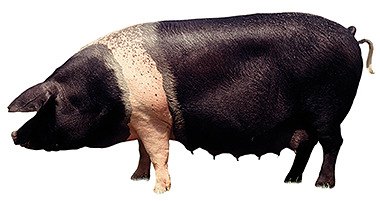
Museum archives: Pig Stories...
When Harry Joyes described to us how, as a lad in the 1920’s, he had ridden pigs into one of Steyning’s slaughterhouses, holding on to their ears to stop himself from falling off, it was just one of the pig stories recorded in Steyning Museum’s archive. He was working for Sam Earl, who Harry said ‘drank a bit’, at the butchers where the sweet shop is now.They are very visual memories. One Museum visitor described how his uncle, who he described as a kind hearted man, would often visit Steyning Market on Wednesday mornings.
He traded in chickens and eggs but one week, after a few drinks at the Railway Inn, he was persuaded by an acquaintance, that there should be no problem at all in taking a pig down to Lancing in the back of his old Morris Traveller.
In his slightly befuddled state, he agreed to do this – before he had seen the pig. It was an enormous sow which, by the time he had reached the Cement Works, was doing its best to join him in the front seat. Our visitor then left the rest of the story to our imaginations.
It was John Carter, who was the last station master at Steyning before the Steyning Line was closed in 1964, who told us the story of the escaping piglet. Most animals brought to and taken away from the market, which was held immediately behind the station buildings, were put in special trucks but piglets had to be transported in the guard’s van.
On one occasion a piglet got loose and went racing and squealing down Steyning station’s ‘up’ platform chased by the guard. Because everything carried in the guards van was officially designated as a parcel we were assured that the guard was yelling, as he ran, ‘Stop that Parcel’.
Pigs must often have got loose. Many of them, after all, were kept in cottage gardens. So it is not a particular surprise to find that there are records of this happening in the past. Proceedings of courts held in Steyning during the reign of Edward IV (1461-1483) record a very exact description of how ‘A grey pig, about 2 years old, has escaped and is causing a nuisance through the vill’ and, on another occasion, how ‘John Hyder permits his pigs to go into the High Street to the annoyance of all the burgesses and the other tenants there in commonalty’. No doubt the pigs contributed to the ‘Dung in the High Street and other filth’ which was frequently complained of.
It is not the earliest mention of pigs in Steyning. That was in Domesday when the extent of woodland could be measured in terms of the number of pigs it could support – 68 in the manor of Steyning. And, even before that, we know from archaeological excavations that the pig was important to the Romano-British people who built the temples on Chanctonbury. The predominant animal remains there were pigs’ heads. Moreover, a small image of a pig moulded in bronze was found at the foot of the hill south of Washington.
Returning to the 1920’s the earthy humour associated with pigs is recalled by John Cox when he was working at Steyning market. One of the auctioneers, George Harwood, who always sold the pigs, was not a very perceptive man. From time to time John and the other lads would play pranks on him; they would find the largest sow or boar, drive the animal into a single pen so that it was facing the catwalk where George stood and where he could only see its head and back, and change the sex on the sale sheet.
He would loudly announce the sex of the animal – to be greeted, of course, by peals of laughter and some coarse comments from the buyers who stood at the rear end. George never rumbled the deception and would always end the day at his favourite inn consuming hot pork sausages washed down with mulled ale – and would then complain bitterly of wind on the following day.

